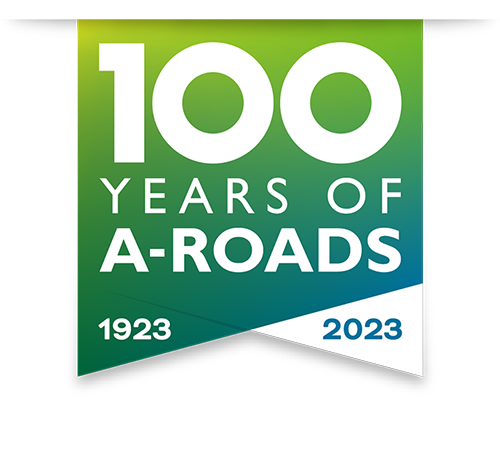100 years of A-roads

100 years
of A-roads
Share this page
The British road numbering system
2023 marked 100 years since the Great Britain road numbering scheme was introduced. Before this, if you weren’t a local, it was very difficult to tell one road from another, and new car owners often got lost when driving longer distances. The Government’s new roads investment programme also meant that it was vital to know which road was which, and to track how money was being invested.
To make sense of the road system, each one was given a single letter to represent its category, followed by one or more numbers. Important roads between large towns and cities, and major connecting routes, became classified as A-roads. Perhaps the most famous road to be renamed was the Great North Road from London to Inverness, which became the A1. In 1936, the Trunk Roads Act created a national strategic road network, and would later come to include the new Motorways, which began to open in the late 1950s.
Keeping the country moving
Modern A-roads still play a vital role in helping millions of people to travel smoothly, speedily, and safely across the country. The roads often cover long distances and take through traffic away from busy towns and city centres. For thousands of businesses, A-roads are essential to their commercial success and growth, and they depend on them for sourcing workers, receiving supplies and making deliveries.
Today, A-roads make up over half of England’s strategic road network, which is 4,300 miles of trunk roads and motorways. Although these roads are in England, they play an essential role in connecting all parts of the United Kingdom. A-roads often follow routes that have been used by people and communities for centuries. At National Highways we’re committed to our responsibility for the ongoing stewardship and evolution of these important roads, now and for the future.
The A30
What we now call the A30 stretched from London to Land’s End and was the route stagecoaches took to the south west. But it was also the haunt of highwaymen who robbed passengers of their riches.
Nowadays things are very different. The A30 is still vital to the region, but today’s journeys are much safer and smoother. In the summer months, Cornwall gets busy as tourists head to beaches and attractions like the Eden Project and Land’s End.
Over the years we’ve upgraded parts of the A30 to dual carriageway. The Chiverton to Carland Cross project is our latest scheme, designed to ease congestion and help the local economy to grow.
The A1
The A1 takes the route of the Great North Road, the main highway connecting the capital cities of England and Scotland. The A1 covers 410 miles and is the longest numbered road in the UK. The importance of this connection is why it was given the number ‘1’ when it became Britain’s first numbered road in 1921.
The A1 not only connects the UK, but is also part of a key route providing access to international destinations. It links several airports, including Heathrow and Stansted, as well as vital trade ports such as Felixstowe. Passing through 17 counties and supporting many businesses that flourish alongside it, the A1 is an essential corridor, used by commuters, hauliers and holiday makers alike.
The A12
If you regularly drive on the A12 in the east of England, you’re travelling a route that Roman warriors, Celtic fighters and medieval rebels have taken before you.
Parts of the London to Lowestoft route date back over 2,500 years, to the time of the Celts. Roman Britons gave it a makeover, creating one of the country’s first paved roads and extending it to their capital, Colchester. In 1922, the route became the A12 as part of the Great Britain road numbering scheme.
In this video we take a look at the A12’s fascinating history, and also at our plans for its future.
